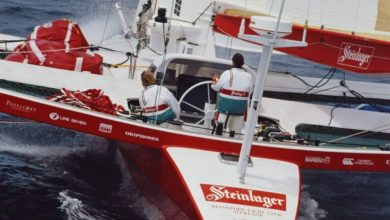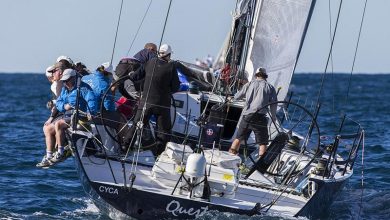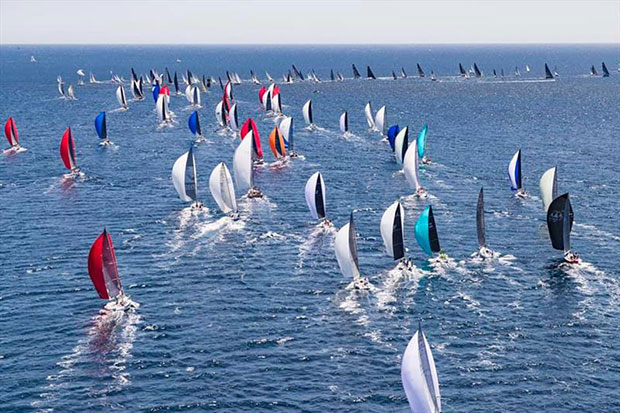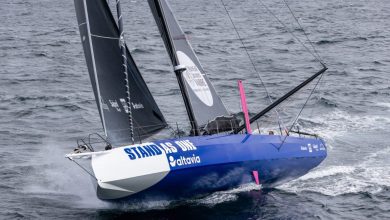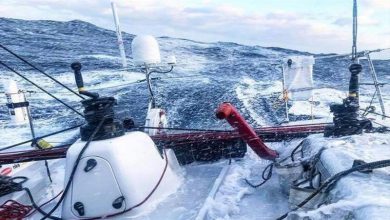50th Rolex Fastnet Race
Appropriately, given the 2023 Rolex Fastnet Race will be the 50th edition of the Royal Ocean Racing Club’s premier event, a significant number of classic yachts are entered, competing for the Dorade Cup.
In 2021, Paul Moxon’s Amokura was the oldest boat in the race and returns again.
The Fred Shepherd 50ft Bermudan yawl was built by A. H. Moody and Son Ltd, Swanwick in 1939, originally for Lord Mountbatten’s Aide de Camp, Ernest Harston. For Amokura, the Fastnet has been a case of ‘third time lucky’: she competed in 1959 and in 2019 but only finished for the first time in 2021. Perhaps it was the change of course to Cherbourg which helped – Amokura was the first British yacht to visit Cherbourg following WW2. Amokura’s recent Rolex Fastnet Races have been all the more remarkable since Paul Moxon has raced his heavyweight classic doublehanded.

Paul Moxon’s 50ft Bermudan yawl Amokura – photo © Rick Tomlinson / www.rick-tomlinson.com
This year’s oldest entry pre-dates the first Fastnet Race by 22 years and is even 10 years older than the first race’s winner, Jolie Brise. Among classic yachts, Moonbeam (ex-Moonbeam III/Moonbeam of Fife) is famous – a 1903 gaff yawl Fife, the third of four Moonbeams for British lawyer Charles Plumtree Johnson. In 1988 she was ‘saved’ in Cyprus and underwent a thorough refit in the UK, including a change to her present cutter rig. Since then, she has been a regular star of La Nioulargue/Les Voiles de Saint-Tropez, where she has often raced against Moonbeam IV and Tuiga.
Today she is part of a trio of Fifes based in Brest, also including Moonbeam IV and Mariquita. Their owners were keen to compete in the Rolex Fastnet Race and made their choice because “Moonbeam is a better sailing boat in stronger wind – it is easier to handle and more seaworthy. On the bigger ones we always need 20 people to sail them – which is a lot. It is easier with Moonbeam,” explains French offshore racig legend Jacques Caraës, who now runs the boats and will skipper Moonbeam. He knows the race well having ended his first in a liferaft in 1979, after his crew was forced to abandon their ¾ Tonner Alvena. Caraës, a Whitbread Round the World Race competitor and Jules Verne Trophy record holder, last competed in the race on Bernard Stamm’s IMOCA 60 Cheminées Poujoulat in the 2000s.
Caraës acknowledges that typically they only race Moonbeam inshore and for the Rolex Fastnet Race her crew will be a mix of classic yacht stalwarts and Breton offshore racers. “I appreciate a lot that the RORC has said we can enter. I’m sure there won’t be many boats of this age.”

The oldest yacht in this year’s Rolex Fastnet Race is the beautiful 1903 Fife gaff yawl Moonbeam – photo © Benoit Couturier
Certainly, a classic making one of the longest journeys to the Rolex Fastnet Race’s 22nd July start will be Maluka. Well known in the Rolex Sydney Hobart, this 9m long 1932 vintage gaff-rigged classic was restored in 2006 by Sean Langman, a Hobart race veteran and industry figure (he owns Noakes Group, which operates boat/shipyards in North Sydney and Port Huon, Tasmania). Ironically Langman, a keen 18ft skiff sailor, is better known for competing in the fastest maxis, so racing Maluka, usually the oldest and smallest boat in the race, was an unusual step. However, she is part of Hobart race folklore having been sailed by an amateur crew from Sydney to Port Huon nine years prior the first Hobart Race. Langman restored her in time to compete in the 2006 Rolex Sydney Hobart in order to celebrate the 70th anniversary of this voyage. In the 2022 race she was campaigned to a class win by Langman’s son Peter (while he raced his present maxi, the former STP65 Moneypenny).
 Stormvogel returns for the 50th Rolex Fastnet Race having won line honours in 1961 and finished seventh overall in 2021 © Rolex / Kurt Arrigo
Stormvogel returns for the 50th Rolex Fastnet Race having won line honours in 1961 and finished seventh overall in 2021 © Rolex / Kurt Arrigo
Langman is shipping Maluka to compete in the Rolex Fastnet Race having holidayed in the UK last year and wanting to take on a fresh challenge. He explains: “Now at 90 years old, Maluka should fit in well with 100 years of the Fastnet. Maluka has been an integral part of my son Pete’s upbringing. He did his first Hobart race on her at age 18 as skipper. Maluka racing offshore is for our team a connection with the purity of the sport. Our quest is to start and finish and mostly enjoy the sailing and each other’s company. The crew consists of myself, Pete Langman, Josh Alexander, Peter Inchbold and Gordon Maguire.” That would be the Sydney-based Irishman and Whitbread Round the World Race legend Gordon Maguire.

Maluka – certain to be one of the oldest and smallest yachts in this year’s Rolex Fastnet Race. Sean Langman’s 9m 1932 vintage gaff-rigged classic is being shipping to the UK from Australia – photo © Rolex / Carlo Borlenghi
Post-WW2 ‘modern classics’ are also well represented. One of the most successful yachts of the 1960s, and perhaps the first modern day maxi, returns for a second consecutive time: the 22.6m ketch Stormvogel was launched in 1961 for Dutch plywood tycoon Cornelius Bruynzeel. His ties to the Fastnet Race are strong having won the 1937 race outright aboard his S&S yawl Zeearend. The 1961 Fastnet was Stormvogel’s first ever race, and she claimed line honours before heading off a successful globe-trotting program that took in the Newport-Bermuda, Gotland Runt, Transpac, Sydney Hobart, China Sea Race, Middle Sea, among others. Proving to be still highly competitive 60 years on, in the 2021 Rolex Fastnet Race she finished seventh overall of 181 finishers in IRC Overall.

The 1961 22.6m ketch Stormvogel returns for her second Rolex Fastnet Race – photo © Rolex / Kurt Arrigo
Two of Stormvogel’s original competitors from the 1960s are competing this year. It will be the first time Germania VI (of a similar size and vintage to Stormvogel, only built in welded aluminium to a Sparkman & Stephens design) will compete in the Fastnet Race. Originally built for the Krupp family, she has spent most of the last 50 years being used for training young sailors and has competed in many of the world’s top offshore races including Newport-Bermuda, Buenos Aires-Rio and several transatlantics. The program was rejuvenated in 2016 and is now led by a trio of skippers including Jens Seiderer and Katrin Hilbert, both of whom have previously competed in RORC major offshore events such as the Sevenstar Round Britain and Ireland Race, Rolex Fastnet Race and Caribbean 600 aboard Norddeutsche Vermögen Hamburg and Haspa Hamburg.
“The Rolex Fastnet Race is the perfect benchmark to show that we and Germania VI have developed and that we can also meet current standards and not just have to live off the glory of earlier times,” explains Seiderer, who will compete with a crew including five more experienced sailors and five trainees aged 16-30.
Largely original, Germania VI has been upgraded to make her more usable: “Four years ago we replaced the 8m long aluminium spinnaker pole, which needed three people to lift it, to a much lighter carbon one,” says Seiderer.
A close relation of Germania VI and frequent rival of Stormvogel is another aluminium S&S design, the 73ft Kialoa II, originally launched as a sloop (but now a yawl) and campaigned heavily throughout the 1960s by American Jim Kilroy. Compared to Stormvogel, Kialoa II’s program was more US-based, but the two competed notably in the 1967 Transpac when Stormvogel won line honours.
After Kilroy moved on to his first IOR maxi, Kialoa II changed hands and was eventually acquired by present owners Paddy and Keith Broughton. Both are highly experienced yachtsman having campaigned the Swan 51 Grandee since the mid-1990s in races from the Rolex Fastnet Race to the Sydney Hobart and Kenwood Cup. In 2016 they graduated up to Kialoa II with the aim of following a similar program to Kilroy’s at his height: entering both the Rolex Fastnet Race and Sydney Hobart in 2017 and sailing between the two. For this year’s Rolex Fastnet Race they are delivering Kialoa II from Sydney on her own bottom, a voyage due to have gone via Cape Horn until some forestay issues forced them to divert to Tahiti. At the time of writing, Kialoa II was en route to Panama.

Furthest travelled? Paddy and Keith Broughton’s Kialoa II is being sailed all the way from Sydney, Australia to compete in the Rolex Fastnet Race in July – photo © Rolex / Carlo Borlenghi
A more modest yacht of this vintage is Pierre Legoupil’s Cherbourg-based Le Loup Rouge, which although French owned is a British design, a 1962 11m Maïca from the board of former RORC Commodore John Illingworth and Angus Primrose. Lowest rated in the 2021 Rolex Fastnet Race, Le Loup Rouge was last to arrive in her homeport, winning the Galley Slaves Trophy. She remains in excellent condition and although kept in her original ‘spirit’ has been discretely upgraded with aluminium boom and spinnaker pole, a modern engine and fittings and Dacron sails.
This year will see strong competition for the Sparkman & Stephens Trophy, appropriate given that the famous design house’s reputation was forged upon the success of Dorade, back-to-back overall winner in both 1931 and 1933. In addition to the famous maxis mentioned, are a plethora of S&S designs, especially from Nautor – the Swan 36, 43, 441, 48, 55 and 65. Winner of the Trophy in 2021, and returning for 2023, is stalwart competitor Harry J. Heijst and his S&S 41 Winsome, along with another Rolex Fastnet Race regular Ben Morris’ Brixham-based Swan 55 Lulotte, the 2019 winner who will be competing in his tenth Fastnet.

Pierre Legoupil’s Cherbourg-based 1962 Maïca Le Loup Rouge – photo © Pierrick Contin / www.pierrickcontin.com
In addition, there is the welcome return of Sunstone, the 1965 S&S 39 aboard which Tom and Vicky Jackson hoovered up most available RORC silverware in the late 1980s/early 90s, before being taken on a massive 200,000 mile round the world cruise until 2015. Sunstone’s new custodian is Will Taylor-Jones. Richard Loftus’ Swan 65 ketch Desperado of Cowes has possibly raced more Fastnets than any other yacht and returns. Usually with a crew including several Whitbread Round the World Race legends, Desperado is renowned for its black tie dinners at the Fastnet Rock, but is always raced hard – in 1989 (when the race was scored under three different rating systems) she won overall under CHS.
Making the trip once again across from the USA is the S&S 49 Hiro Maru campaigned by Hiroshi Nakajima. A former Transpac and SORC class winner under her original name Scaramouche, Hiro Maru with her present owner won her class in the 2019 west to east Transatlantic Race before going on to compete in that year’s Rolex Fastnet Race, returning again 2021.
For Finland’s Tapio Lehtinen, the race will be a warm-up before he takes his Swan 55 Galiana round the world in September’s Ocean Globe Race. This will also be the case for the Mauric 60 Neptune, which competed in the second Whitbread Round the World Race in 1977-78 under France’s Bernard de Guy is now skippered by Tan Raffray. Neptune started the 1977 Fastnet Race, but never finished.
Also returning is the Nicholson 55 Quailo III, originally built for RORC Commodore Don Parr, that finished second overall in the 1971 Fastnet Race before going on to represent the UK in the 1973 Admiral’s Cup and in that year’s Sydney Hobart.

&S 49 Hiro Maru campaigned by Hiroshi Nakajima – photo © Rolex / Carlo Borlenghi
The 50th edition of the Rolex Fastnet Race starts from Cowes, Isle of Wight on Saturday 22nd July. For further information, please go to the Rolex Fastnet Race website: www.rolexfastnetrace.com
by James Boyd / RORC

